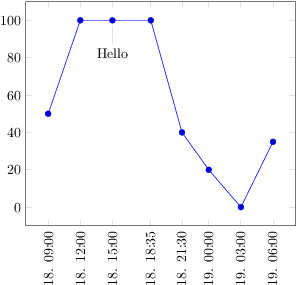|
Ich möchte in einem Graph ein Extremwert beschriften. In einem normalen Graph klappt das ganz gut: \documentclass{scrartcl} \usepackage{amsmath} \usepackage[normalem]{ulem} \usepackage{tikz} \usepackage{pgfplots} \pgfplotsset{compat=newest} \begin{document} \begin{tikzpicture} \addplot[no markers, blue, domain=0:10000, samples=10, % you can make it larger restrict x to domain=0:5000,% but this filter the results anyway restrict y to domain=0:100000, samples=300 ] { 93231-3.552e-10*x^5}; \node[ coordinate, pin = {[rotate=90]right:1000} ] at (axis cs:1000,10000) { }; \end{axis} \end{tikzpicture} \end{document} Nur, was mache ich, wenn die x-Achse aus Datumsangaben in der Form JJJJ-MM-TT besteht? Wenn ich z.B. 2017-01-01 eingebe |
|
Mit dem Beispiel aus der Anleitung funktioniert es einwandfrei. \documentclass{article} \usepackage{pgfplots} \usepgfplotslibrary{dateplot} \pgfplotsset{compat=newest} \begin{document} \begin{tikzpicture} \begin{axis}[ date coordinates in=x, xtick=data, xticklabel style= {rotate=90,anchor=near xticklabel}, xticklabel=\day. \hour:\minute, ] \addplot coordinates { (2009-08-18 09:00, 050) (2009-08-18 12:00, 100) (2009-08-18 15:00, 100) (2009-08-18 18:35, 100) (2009-08-18 21:30, 040) (2009-08-19, 020) (2009-08-19 3:00, 000) (2009-08-19 6:0, 035) }; \node[pin={below:Hello}] at (axis cs:2009-08-18 15:00, 100) {}; \end{axis} \end{tikzpicture} \end{document}
|


Also
(axis cs:100,2017-01-01)kann nicht funktionieren, wenn das Datum in der x-Koordinate sein soll.Ohje, x und y-Achse vertauscht. Zu viel Bäume, zu viel Wald. Danke.